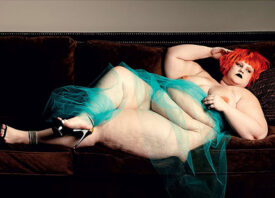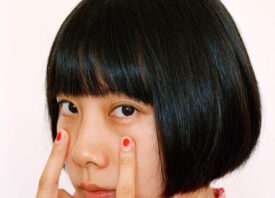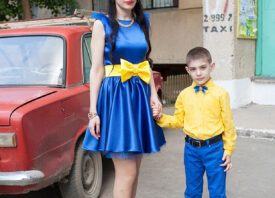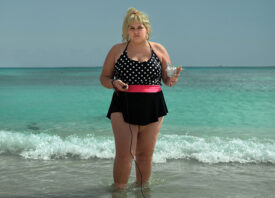Search this site
‘Who Is Afraid of Women Photographers?’ Exhibition Honors a Century of Female Image-Makers
Margaret Bourke-White (1904-1971), Self-portrait with camera, © Digital Image Museum Associates/LACMA/Art Resource NY/Scala, Florence
Alice Austen (1866-1952), Trude and I masked, short skirts © Courtesy of Historic Richmond Town, Staten Island, New York
In 1863, a recently married young woman gave a camera to her middle-aged mother in hopes of keeping her occupied and entertained during long months alone without her now-grown children and then-traveling husband. The mother had always been a pious woman, the friend of noted artists of the time, and the neighbor Poet Laureate Alfred Tennyson, with whom she later collaborated by illustrating his Arthurian cycle Idylls of the King. Despite her relative success in the photographic field, the woman photographer’s name, Julia Margaret Cameron, would not become familiar and instantly recognizable to art historians until almost three quarters of a century after death in 1879.
Of course, Cameron was not the only female photographer to have been left behind in the wake of her better recognized male counterparts. A new exhibition Who is afraid of Women Photographers? 1839-1945, presented in parts first at Musée de l’Orangerie and second at Musée d’Orsay in Paris, reveals over a century’s worth of stones unturned, of women who in one way or another have been forgotten by history despite their lasting influence on the art and practice of photography.
Part One of the exhibition runs from the mid-1800s through the first two decades of the 20th century, highlighting the ways in which Victorian and prewar women used the medium to tell stories most often left untold, stories of domesticity, childrearing, and ultimately, the very start of the First Wave and the fight for women’s rights. Where painters’ and sculptors’ studios were normally closed to women, a camera-wielding female could earn an apprenticeship, meet influencers, and eventually earn the chance to branch out on her own professionally.
Part Two takes the close of the First World War as its point of departure, positioning its featured photographers within the context of the novel idea of The New Woman, a career-oriented and well educated female who left behind the confines of the home to enter autonomously into the public, industrial sphere. As women were grappling with new roles and boundaries, suggests the exhibition, the photographers among them turned to self-portraiture as a means of redefining and reasserting a freshly emerging feminine ideal. As journalists and advertisers especially, women in the interwar years could step onto political and commercial territory that was unimaginable for their predecessors. The built schools and collectives; they formed agencies and studios; they became critics and curators.
In 1865, when Cameron first applied to the Photographic Society of Scotland, she was met with a particularly scathing review from The Photographic Journal, where the critic ended his assessment with the qualifier, “We are sorry to have to speak thus severely on the works of a lady, but we feel compelled to do so in the interest of the art.” For the sake of art, then, that Who is afraid of Women Photographers? undoes decades’ worth of dismissal, honoring the women who helped shape an art that defined a century.
Who is afraid of Women Photographers? 1839-1945 runs until January 24th at Musée d’Orsay and Musée de l’Orangerie.

Lady Frances Jocelyn (1820-1880), Intérieur, 1865 © Courtesy of Washington National Gallery of Art

Julia Margaret Cameron (1815-1879), Vivien and Merlin © Musée d’Orsay, Dist. RMN-Grand Palais / Patrice Schmidt

Christina Broom (1862-1939), Jeunes suffragettes faisant la promotion de l’exposition de la Women’s Exhibition de Knightsbridge, Londres, May 1909 © Christina Broom/Museum of London

Julia Margaret Cameron (1815-1879), Mrs Herbert Duckworth, 12 April 1867 © Paris, Bibliothèque nationale de France

Frances Benjamin Johnston (1864-1952), Self-Portrait in the studio, c. 1896 © Library of Congress, Prints & Photographs Division [LC-USZ62-64301]

Frances Benjamin Johnston (1864-1952), Mills Thompson travesti, c. 1895 © Library of Congress, Prints & Photographs Division [LC-USZ62-64301]

Frances Benjamin Johnston (1864-1952), Marins dansant la valse à bord de l’USS Olympia, 1899 © Library of Congress, Prints & Photographs Division [LC-USZ62-77906]

Frances Benjamin Johnston (1864-1952), Autoportrait en travestie vélocipédiste, 1890-1900, 1899 © Library of Congress, Prints & Photographs Division [LC-USZ62-77906]

Gertrude Käsebier (1852-1934), The Red Man, 1900 © Digital image, The Museum of Modern Art, New York/Scala, Florence

Gertrude Käsebier (1852-1934), Gertrude Käsebier O’Malley jouant au billard avec William M. Turner, c. 1909 © Photo courtesy of the J.Paul Gatty Museum

Helen Messenger Murdoch (1862-1956), Enfants de Bishareen, Assouan, Egypte, 1914 © Royal Photographic Society / National Media Museum Science & Society Picture library

Frances Benjamin Johnston (1864-1952), Stairway of the Treasurer’s Residence: Students at Work (The Hampton Institute), 1899-1900 © 2015. Digital image, The Museum of Modern Art, New York / Scala, Florence

Mary Dillwyn (1816-1906), The picnic Party (Oystermouth Castle), Private Collection

Jessie Tarbox Beals (1870-1942), Le Président des Etats-Unis Theodore Roosevelt, Edith Roosevelt et David Rowland à l’Exposition universelles de Saint-Louis, Missouri, 1904 Digital image © National Portrait Gallery, Smithsonian Institution; gift of Joanna Sturm

S. Hoare, Indigène des marquises, 1880-1885 Digital Image 2015 © Musée du quai Branly/Photo Scala, Florence

Ruth Bernhard (1905-2006), Embryo, 1934 © Photo courtesy of the Keith de Lellis Gallery, New York

Tina Modotti (1896-1942), Woman with Flag, 1928 © 2014. Digital image, The museum of Modern Art, New York/Scala, Florence

Elfriede Stegemeyer (1908-1988), Self Portrait, 1933, © Digital Image Museum Associates/LACMA/Art Resource NY/Scala, Florence

Ruth Bernhard (1905-2006), Doll, 1938 © Digital Image Museum Associates/LACMA/Art Resource NY/Scala, Florence

Ella Maillart (1903-1997), Descente du col de Djengart à la frontière de la Chine. Kirghisie © Musée de l’Elysée, Lausanne /Fonds Ella Maillart

Dorothea Lange (1895-1965), Human Erosion in California (Migrant mother), © Münchner Stadtmuseum, Sammlung Fotografie © Dorothea Lange Collection, Oakland Museum, Oakland, USA

Barbara Morgan (1900-1992), We are three women – We are three million women, 1938 © Münchner Stadtmuseum, Sammlung Fotografie

Regina Relang (1895-1989), Beim Rennen in Longchamp, 1936 © Münchner Stadtmuseum, Sammlung Fotografie, Archiv Relang

Helen Levitt (1918-2009), New York, c. 1940 © Estate of Helen Levitt © Photo courtesy of the National Gallery of Art, Washington

Consuelo Kanaga, Annie Mae Merriweather, 1936 © Collection International Center of Photography





